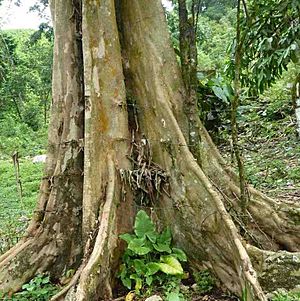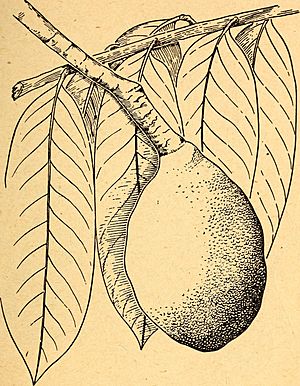Sun sapote facts for kids
Licania platypus, also known as sun sapote, sansapote, or monkey apple, is a beautiful flowering tree. It belongs to the Chrysobalanaceae family. This tree is known for its interesting fruit and can grow quite tall.
Quick facts for kids Sun sapote |
|
|---|---|
 |
|
| Trunk of a large Licania platypus tree | |
| Conservation status | |
| Scientific classification | |
| Genus: |
Licania
|
| Species: |
platypus
|
| Synonyms | |
|
|
The sun sapote tree has many different names depending on where you are. Some of these names include sonzapote, sungano, zapote cabelludo, zapote amarillo, and chupa.
| Nutritional value per 100 g (3.5 oz) | |
|---|---|
| Dietary fiber | 0.9-2.5 g |
|
0.26-0.49 g
|
|
|
Protein
|
0.230-0.291 g
|
| Vitamins | Quantity
%DV†
|
| Vitamin A equiv.
beta-Carotene
|
154%
157-273 μg |
| Thiamine (B1) |
-14%
0.005-0.16 mg |
| Riboflavin (B2) |
-2%
0.013-0.027 mg |
| Niacin (B3) |
-8%
1.466-1.530 mg |
| Vitamin C |
-32%
11.0-35.6 mg |
| Minerals | Quantity
%DV†
|
| Calcium |
7%
10.5-33.2 mg |
| Iron |
-13%
0.52-1.70 mg |
| Phosphorus |
20%
24.5-29.1 mg |
| Other constituents | Quantity |
| Water | 64.6-67.4 g |
| †Percentages estimated using US recommendations for adults. | |
This table shows some of the nutrients found in a raw Licania platypus fruit. It contains water, protein, and some vitamins and minerals like Vitamin C and iron.
Contents
Where Sun Sapote Grows
The Licania platypus tree naturally grows in southern Mexico and goes all the way south to northern Colombia. It likes to grow in thick forests, usually up to 2000 feet (about 600 meters) high. People have also brought this tree to other places like India, the Philippines, Trinidad and Tobago, Florida, and Hawaii.
What the Tree Looks Like
The sun sapote tree stands very straight and tall. It can grow to be 100 to 160 feet (30 to 50 meters) high. That's as tall as a 10 to 15-story building! It has a thick, round top with lots of leaves.
The bark of the tree is dark purplish to brown. It has small white or reddish-white dots called lenticels on it. Sometimes, the bottom of the trunk spreads out, like a buttress, to help support the tall tree.
Leaves and Flowers
The leaves of the sun sapote tree fall off each year. They grow one after another along the branch, or sometimes in a spiral. Each leaf is shaped like an oval with pointed ends. They are about 4 to 12 inches (10 to 30 centimeters) long and 1.25 to 3.5 inches (3 to 9 centimeters) wide. They have a thick line down the middle. When new leaves grow, they are a pretty bronze or reddish-purple color.
The tree produces many small, fuzzy flowers that smell nice. These flowers grow in large bunches called panicles, which can be 4 to 14 inches (10 to 35 centimeters) long. The petals of the flowers curve backward, and many stamens (the parts that hold pollen) stick out.
The Fruit
Only a few fruits grow from each flower cluster, usually 1 to 3. The fruit is edible and shaped like a pear or an upside-down egg. It is quite large, measuring 5 to 8 inches (13 to 20 centimeters) long and 4 to 5.5 inches (10 to 14 centimeters) wide.
The skin of the fruit is thin and can be a bit bumpy. It is dark brown to reddish with small white dots, just like the bark. Inside, the fruit has orange-yellow or yellow flesh. It smells a bit like pumpkin and can be soft, stringy, and either dry or juicy. The taste is mildly sweet, similar to a sapodilla. Most fruits have one large, flat seed inside. The seed is 2.375 to 4 inches (6 to 10 centimeters) long.
Growing Conditions
The sun sapote tree usually blooms, or flowers, from July to September. The fruits then grow and ripen from August to December of the next year. A tree starts producing fruit when it is about 10 years old. This tree likes warm weather and cannot handle frost or temperatures below 4.5 degrees Celsius (40 degrees Fahrenheit).
How it Handles Dry Weather
The Licania platypus tree is surprisingly good at handling dry weather. It can survive droughts better than many other trees from central Panama. Studies showed that young trees might wilt a little when they don't get enough water, but they can still survive even when conditions are very dry.
Uses of the Tree
People plant the sun sapote tree in Central America because it is pretty and provides good shade. The fruits are eaten, especially when other fruits are not available. Sometimes, you can find them for sale in local markets. Animals like tapirs and peccaries also eat the fallen fruits from the ground.
The wood of the tree is strong and heavy, with a fine grain. It is sometimes used to make furniture and cabinets. However, it is not used very often because the trees are not cut down very frequently.
See also
 In Spanish: Sonzapote para niños
In Spanish: Sonzapote para niños



